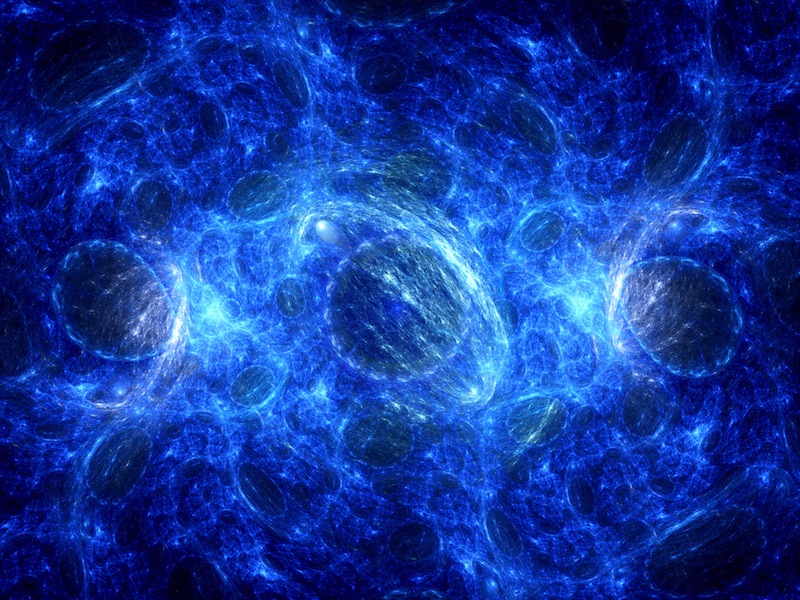If Extra Dimensions Do Exist, They Must Be Really, Really Small

Does our universe exist in more than just three dimensions?
Probably not on large scales, according to new research published July 23 in the Journal of Cosmology and Astroparticle Physics. The study found that across vast distances in space, the universe likely operates in just the dimensions we experience on Earth. The results are also helping scientists better understand the puzzling nature of dark energy, the mysterious phenomenon behind the accelerating expansion of the universe.
In October 2017, scientists used the Laser Interferometer Gravitational-Wave Observatory (LIGO) to detect a gravitational wave produced in the collision of two neutron stars. Dubbed GW170817, the event was also seen with traditional telescopes, allowing the scientists to simultaneously study the occurrence via gravitational waves and light waves. The dual measurements are allowing scientists to learn all sorts of things about our universe, including how many dimensions it might hold. The new results also offer additional evidence for Albert Einstein's general relativity. [8 Ways You Can See Einstein's Theory of Relativity in Real Life]
"General relativity says gravity should be working in three dimensions, and [the results] show that that's what we see," said Kris Pardo, lead author on the study and a doctoral student at Princeton University.
While general relativity has proven so far to be spot-on in describing our universe, there's one thing it can't explain very well: why our universe's expansion is accelerating. Scientists nicknamed the cause for this acceleration "dark energy," but no one knows what it is. Some theories modify gravity to explain the expansion, suggesting gravity works differently on large scales. Many of these ideas predict that other dimensions exist, and these could be probed by gravitational waves.
"This whole effort of looking for modified theories of gravity is in essence driven by the dark energy mystery. We're trying to find: Is there a way that we can tweak the laws of gravity to explain why the universe's expansion is speeding up?" said Tessa Baker, a cosmologist at Oxford University in England who was not involved in the study.
According to many of these theories, if extra dimensions do exist, gravitational waves would "leak" into those dimensions, causing the waves to weaken as they made their way across the universe. The scientists in the recent study measured how far the gravitational waves and the light waves from GW170817 traveled to reach Earth, but the researchers didn't find any hints of the weakening that would be associated with extra dimensions.
Get the Space.com Newsletter
Breaking space news, the latest updates on rocket launches, skywatching events and more!
In the wake of the GW170817 event, many studies ruled out some of the modified gravity theories by calculating the speed of gravitational waves to determine their travel-time delay. This new paper is able to dismiss a whole other set of theories, Bakertold LiveScience.
The new results exclude only large dimensions. As such, they do not place any constraints on the 10-plus dimensions predicted by string theory — a theory in physics that suggests everything is made up of tiny vibrating strings. However, the new findings do show that across scales of about 1 mile (1.6 kilometers) up to at least 80 million light-years, the universe is three-dimensional. The finding further dismisses even larger dimensions, but only if they have visible effects on physics on scales smaller than 80 million light-years.
The researchers also used the data to calculate the lifetime of the graviton, a theoretical particle that, if it exists, conveys the force of gravity. That lifetime is at least 450 million years, the scientists found. In other words the graviton isn’t decaying into lighter particles over this time. Some modified gravity theories predict such a decay, so this calculation of the graviton’s lifetime could be used in future gravitational wave events that occur in other parts of the universe, helping to further test these theories.
The GW170817 collision event "was very, very local in cosmological terms — basically on our doorstep," Baker said. But physicists would really like to see more events at greater distances (which would have occurred further back in time), because those would reveal if gravity or dark energy have changed over time, Baker added.
For now, the universe appears to have only those dimensions we're used to. But don't despair, science fiction writers and time-travel aficionados — smaller, compact dimensions may still be out there.
Originally published on Live Science.
Join our Space Forums to keep talking space on the latest missions, night sky and more! And if you have a news tip, correction or comment, let us know at: community@space.com.

Mara Johnson-Groh is a contributing writer for Live Science. She writes about everything under the sun, and even things beyond it, for a variety of publications including Discover, Science News, Scientific American, Eos and more, and is also a science writer for NASA. Mara has a bachelor's degree in physics and Scandinavian studies from Gustavus Adolphus College in Minnesota and a master's degree in astronomy from the University of Victoria in Canada.










